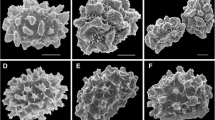Abstract
Mycopteris, a new genus of grammitid ferns, is described and combinations are made for the species that belong to it. Mycopteris is diagnosed by castaneous rhizome scales with turgid cells, usually pectinate laminae, blackish petioles and rachises, blackish pinna costae and veins, reddish setae, cretaceous hydathodes, glabrous sporangia, and the presence of Acrospermum ascomes. It is entirely neotropical, ranging from Mexico east into the West Indies and south to Bolivia. Mycopteris is one of two genera of grammitid ferns that are consistently associated with Acrospermum, an epibiotic ascomycete that produces black clavate fruiting bodies. Seventeen species of Mycopteris are recognized here, including one new species (M. longipilosa) and one elevated from the rank of variety to species (M. costaricensis). The following additional combinations are made here: M. alsopteris, M. amphidasyon, M. attenuatissima, M. cretata, M. grata, M. leucolepis, M. leucostica, M. longicaulis, M. pirrensis, M. praeceps, M. semihirsuta, M. steyermarkii, M. subtilis, M. taxifolia, and M. zeledoniana. Lectotypes are chosen for Ctenopteris leucosticta, Polypodium amphidasyon, and Polypodium pectinatum var. hispidum. For each accepted species, full synonymy and geographical range are provided. Taxonomic discussion is provided for species not widely recognized in previous treatments.


Similar content being viewed by others
Literature Cited
Christensen, C. 1906. Index filicum. Copenhagen, Hagerup.
Copeland, E. B. 1956 ["1955"]. Ctenopteris in America. Philippine Journal of Science 84: 381–473.
Doyle, V. P., M. Sundue & G. J. Samuels. 2008. Evaluating host specificity of epibiotic Acrospermum on neotropical polygrammoid ferns. Inoculum 59: 28.
Hirai, R. Y. & J. Prado. 2012. Monograph of Moranopteris (Polypodiaceae). Pteridologia 4: 1–113.
———, G. Rouhan, P. H. Labiak, T. A. Ranker & J. Prado. 2011. Moranopteris: A new neotropical genus of grammitid ferns (Polypodiaceae) segregated from Asian Micropolypodium. Taxon 60: 1123–1137.
Kessler, M., A. L. Moguel Velazquez, M. A. Sundue & P. H. Labiak. 2011. Alansmia, a new genus of grammitid ferns (Polypodiaceae) segregated from Terpsichore. Brittonia 63: 233–244.
Labiak, P. H. 2011. Stenogrammitis, a new genus of grammitid ferns segregated from Lellingeria (Polypodiaceae). Brittonia 63: 139–149.
——— & J. Prado. 2005. As espécies de Terpsichore A. R. Sm. e Zygophlebia L. E. Bishop (Grammitidaceae) do Brasil. Acta Botanica Brasilica 19: 867–887.
———, G. Rouhan & M. Sundue. 2010a. Phylogeny and taxonomy of Leucotrichum (Polypodiaceae): A new genus of grammitid ferns from the Neotropics. Taxon 59: 911–921.
———, M. Sundue & G. Rouhan. 2010b. Molecular phylogeny, character evolution, and biogeography of the grammitid fern genus Lellingeria (Polypodiaceae). American Journal of Botany 97: 1354–1364.
Lellinger, D. B. 1989. The Ferns and fern-allies of Costa Rica, Panama, and the Chocó (Part I: Psilotaceae through Dicksoniaceae). Pteridologia 2A:1–364.
Morton, C. V. 1967. The genus Grammitis in Ecuador. Contributions from the United States National Herbarium 38: 85–120.
Proctor, G. R. 1985. Ferns of Jamaica, a guide to the pteridophytes. British Museum (Natural History). London
Ranker, T. A., A. R. Smith, B. S. Parris, J. M. O. Geiger, C. H. Haufler, S. C. K. Straub & H. Schneider. 2004. Phylogeny and evolution of grammitid ferns (Grammitidaceae): A case of rampant morphological homoplasy. Taxon 53: 415–428.
Smith, A. R. 1993. Terpsichore, a new genus of Grammitidaceae (Pteridophyta). Novon 3: 478–489.
——— & R. C. Moran. 1995. Terpsichore. Pp. 385–392. In: R. C. Moran and R. Riba (eds. for Pteridophyta), Psilotaceae a Salviniaceae. In: G. Davidse, M. S. Sousa and S. Knapp (general eds.). Flora Mesoamericana, Ciudad de México, Universidad Nacional Autónoma de México.
Sundue, M. A. 2010a. A morphological cladistic analysis of Terpsichore (Polypodiaceae). Systematic Botany 35: 716–729.
———. 2010b. A monograph of Ascogrammitis, a new genus of grammitid ferns (Polypodiaceae). Brittonia 62: 357–399.
——— & M. Kessler. 2008. New species and new records of the fern genus Terpsichore (Polypodiopsida: Polypodiaceae). Organisms Diversity and Evolution 8: 163e1–163e10.
———, M. B. Islam & T. A. Ranker. 2010. Systematics of grammitid ferns (Polypodiaceae): Using morphology and plastid sequence data to resolve the circumscription of Melpomene and the polyphyletic genera Lellingeria and Terpsichore. Systematic Botany 35: 701–715.
———, P. H. Labiak, J. Mostacero & A. R. Smith. 2012. Galactodenia, a new genus of grammitid ferns segregated from Terpsichore (Polypodiaceae). Systematic Botany 37: 339–346.
Stenroos, S., T. Laukka, S. Huhtinen, P. Döbbeler, L. Myllys, K. Syrjänen & J. Hyvönen. 2010. Multiple origins of symbioses between ascomycetes and bryophytes suggested by a five-gene phylogeny. Cladistics 26: 281–300.
Acknowledgments
I thank the curators of the following herbaria for making their material available for study: AAU, B, F, GH, CR, GOET, HUA, INB, K, LPB, MICH, MO, NY, OS, P, RB, QCA, QCNE, UC, UPCB, US, and USZ. Figure 2 is the work of H. Fukuda and used here with permission of Robbin Moran. My studies of grammitid ferns have greatly benefited from the assistance of Paulo Labiak, Robbin Moran, Barbara Parris, Tom Ranker, Germinal Rouhan, and Alan Smith. I thank David Barrington, Larry Kelly, Weston Testo, and two anonymous reviewers for providing helpful comments on the manuscript. This work was supported by the National Science Foundation [DEB-1119695 to Cliff Morden and Tom Ranker]. Support for fieldwork was provided by The Graduate Center at the City University of New York, The Organization for Tropical Studies, the Torrey Botanical Society, the Alice and Rolla Tryon Pteridophyte Library at the University of Vermont’s Pringle Herbarium, and the National Science Foundation [DEB-1020623 to Paola Pedraza].
Author information
Authors and Affiliations
Corresponding author
Rights and permissions
About this article
Cite this article
Sundue, M.A. Mycopteris, a new neotropical genus of grammitid ferns (Polypodiaceae). Brittonia 66, 174–185 (2014). https://doi.org/10.1007/s12228-013-9322-0
Published:
Issue Date:
DOI: https://doi.org/10.1007/s12228-013-9322-0




